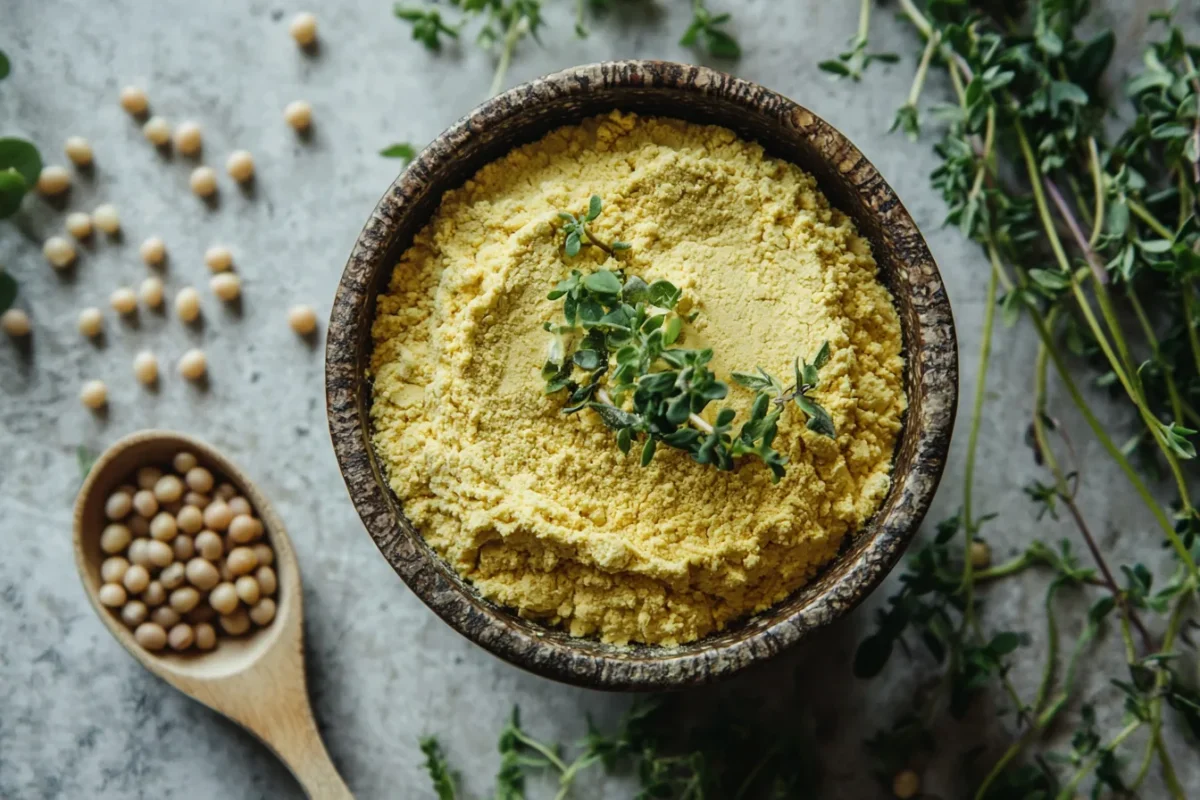Lupin flour is becoming a popular choice in gluten-free and low-carb recipes. But what are the disadvantages of lupin flour? While it offers great nutritional benefits, some drawbacks might surprise you. First, it is known for being high in protein and fiber, making it appealing for health-conscious cooks. Next, its versatility allows it to work well in baking, pasta, and even as a thickening agent.
However, lupin flour is not perfect. It can cause allergic reactions in some people, especially those allergic to peanuts. Also, its slightly bitter taste might not suit everyone’s preference. In addition, using too much lupin flour in a recipe can affect texture and flavor balance.
So, should you avoid it altogether or just use it with care? Keep reading to discover the key disadvantages, tips for safer use, and how to still enjoy its benefits in your favorite recipes.
Table of Contents
Nutritional Limitations of Lupin Flour in Your Diet
Potential Allergies Associated with Lupin Consumption
Lupin flour can be a great gluten-free option, but it may trigger allergies in some people. What are the disadvantages of lupin flour? Allergic reactions are one of the main concerns, especially for those allergic to peanuts. First, symptoms can include itching, swelling, or hives. Next, severe cases might cause breathing difficulties requiring immediate medical attention. Also, cross-reactivity with peanuts increases the risk for sensitive individuals. In addition, even small traces in processed foods can cause a reaction. Always check ingredient labels carefully when buying packaged products. If you’re unsure, consult an allergist before trying lupin flour. Cooking with it at home allows better control over exposure.

For more detailed information on lupin-related allergies, check out the FDA’s guide on lupin allergenicity. Stay informed and listen to your body—it’s always better to be cautious!
Limited Nutrient Profile Compared to Other Flours
While lupin flour has benefits, it doesn’t offer a complete nutritional profile. First, it’s rich in protein, but it lacks essential vitamins and minerals. For example, it contains less calcium and iron compared to wheat or almond flour. Next, relying solely on lupin flour for baking might lead to imbalanced nutrient intake. Also, its amino acid profile isn’t complete, which means it doesn’t provide all essential proteins. Then, lupin flour is lower in certain antioxidants found in other flours. In addition, it may not be suitable as the only flour in a long-term diet. Mixing it with other nutrient-dense flours can help fill those gaps. Also, balancing your diet with fruits, vegetables, and protein-rich foods is essential when using lupin flour. While it’s a great addition to your pantry, it shouldn’t replace other flours entirely. Balance is key!
Digestive Challenges When Using Lupin Flour Regularly
Common Digestive Discomforts Linked to Lupin Flour
Lupin flour might be a healthy option, but it can cause digestive discomfort in some people. What are the disadvantages of lupin flour? Digestive issues are certainly one of them. First, its high fiber content can lead to bloating, gas, or stomach cramps. Next, some individuals may experience these symptoms more severely if their gut isn’t accustomed to high-fiber foods. For a tasty way to introduce lupin flour gradually into your diet, try this Lupin Falafels Recipe.

Also, lupin flour contains compounds that might be harder to digest for certain people. Then, consuming large quantities of lupin flour in one meal can amplify these symptoms. In addition, insufficient hydration can worsen digestive discomfort when consuming high-fiber foods. Drinking plenty of water helps reduce these effects. Also, introducing lupin flour gradually into your diet can give your digestive system time to adjust. Pay attention to how your body reacts—it’s often the best guide to finding your ideal serving size.
Tips to Minimize Digestive Side Effects
If lupin flour causes digestive issues, don’t worry! There are simple ways to reduce those side effects. First, start with small amounts when adding lupin flour to your recipes. Next, pair it with flours that are easier to digest, like rice or oat flour. Also, drink plenty of water throughout the day to support digestion. Then, avoid consuming lupin flour in large portions all at once. In addition, cooking or baking lupin flour thoroughly can make it easier on your stomach. Also, adding digestive-friendly ingredients like yogurt or ginger to your recipes can help. Finally, if discomfort persists, take a break and reintroduce it slowly. Lupin flour is versatile and nutritious, but it’s all about finding the right balance for your body. With these tips, you’ll enjoy the benefits without the bellyaches.
Flavor Profile: Why Lupin Flour Might Not Suit Every Dish
Strong Taste and Its Impact on Recipes
Lupin flour has a unique flavor that doesn’t appeal to everyone. First, it has a slightly bitter, earthy taste that can overpower certain recipes. Next, this flavor works well in savory dishes but may clash with sweet baked goods. Also, some people describe the taste as nutty, but not everyone enjoys it. Then, the distinct flavor can limit its versatility in certain recipes. In addition, even small amounts of lupin flour can alter the overall taste of a dish. Mixing it with other milder flours can help balance its flavor. Also, bold flavors like garlic, herbs, or spices can mask the bitterness. If you’re using lupin flour for the first time, start with savory recipes. That way, you’ll better understand how its flavor works with different ingredients. Don’t let its bold taste intimidate you—just tweak your recipe!
Adjusting Recipes to Balance Lupin Flour’s Flavor
Balancing lupin flour’s bold flavor takes a little practice, but it’s totally doable! First, mix lupin flour with other neutral flours like rice or almond flour. Next, add bold ingredients such as garlic, herbs, or spices to complement the taste. Also, in sweet recipes, you can use vanilla, cinnamon, or extra sweeteners to counterbalance the bitterness. Then, adjust the flour ratio based on the dish—start small and increase gradually. In addition, taste your batter or dough before baking to make sure the flavor feels balanced. Also, baking temperatures play a role. Sometimes, lower oven temperatures can help reduce bitterness. Finally, follow recipes specifically designed for lupin flour for the best results. Once you get the hang of it, you’ll be amazed at how versatile it can be. Keep experimenting and trust your taste buds—they’re the best guide!
Availability and Cost Concerns of Lupin Flour
Price Comparison with Other Gluten-Free Flours
Lupin flour is often more expensive than other gluten-free flours, which can be a drawback. What are the disadvantages of lupin flour? Its price tag is certainly one of them. First, lupin flour is produced in smaller quantities compared to mainstream flours like almond or rice flour. Next, its limited demand in certain regions keeps costs relatively high. Also, specialty health food stores often sell it at premium prices. Then, online retailers might offer better deals, but shipping fees can add up quickly. In addition, buying in bulk can help reduce costs, but it’s not always practical for everyone. Price comparisons reveal that lupin flour often costs two to three times more than common gluten-free alternatives. Also, keeping an eye out for sales or discounts can save you money. While the cost might be a barrier, its nutritional benefits may still make it a worthwhile investment.
Challenges in Finding Lupin Flour Locally
Finding lupin flour locally can sometimes feel like a treasure hunt. First, it’s not commonly stocked in regular grocery stores. Next, health food stores or organic markets are your best bet for finding it. Also, even these stores might have limited stock, depending on the season or supplier availability. Then, online shopping becomes the most convenient option, offering a wider variety of brands and bulk options. In addition, international shipping can sometimes delay deliveries or increase costs. Asking your local store to special-order lupin flour might also be an option. Also, joining online forums or communities focused on gluten-free diets can provide sourcing tips. While availability remains a challenge, persistence often pays off. Don’t give up too quickly—you’ll eventually track down this versatile flour. And once you have it, you’ll realize it was worth the effort!
Cooking and Baking Limitations with Lupin Flour
Textural Differences in Baked Goods
Lupin flour behaves differently in baking compared to traditional flours. First, it absorbs more liquid, which can result in drier baked goods if not balanced properly. Next, it tends to create a dense or chewy texture, especially in cakes and muffins. Also, lupin flour doesn’t rise as well as wheat flour, which can affect fluffiness. Then, achieving the right texture often requires experimenting with ingredient ratios. In addition, recipes that call for lighter textures might not turn out as expected with lupin flour alone. Mixing it with other flours, like almond or coconut, can help balance the texture. Also, adding extra moisture, such as eggs or yogurt, can improve the final result. While it may take a few tries to get things perfect, the results can be worth it. Baking with lupin flour is an adventure—enjoy the process!
Recipe Adjustments for Better Results
Adjusting recipes for lupin flour requires a little patience, but it’s totally manageable. First, start by replacing only a portion of the flour in your recipe with lupin flour. Next, increase moisture content with eggs, yogurt, or oils to avoid dryness. Also, keep an eye on baking times, as lupin flour can dry out faster in the oven. Then, use recipes specifically designed for lupin flour—they’re already tested for success. In addition, flavors like vanilla, spices, or herbs can help balance lupin flour’s distinct taste. Also, don’t be afraid to experiment with texture boosters like xanthan gum or baking powder. Finally, test small batches before committing to larger recipes. With these tips, you’ll soon master the art of baking with lupin flour. Every attempt brings you one step closer to the perfect dish—so have fun with it!
Potential Environmental and Ethical Concerns of Lupin Farming
Farming Practices and Environmental Impact
Lupin farming offers some environmental benefits, but it’s not perfect. First, lupin plants are excellent at enriching the soil with nitrogen, reducing the need for artificial fertilizers. Next, they are also drought-resistant, requiring less water than many other crops. However, large-scale monoculture farming can still lead to soil depletion over time. Also, pesticide use, though lower with lupin crops, can still harm local ecosystems if mismanaged. Then, transporting lupin flour long distances increases its carbon footprint. In addition, smaller farms often practice more sustainable and environmentally friendly methods. Supporting these farms can help reduce environmental concerns. Also, choosing organic lupin flour ensures lower chemical usage and better farming practices. While lupin farming has its challenges, informed choices as consumers can make a positive difference. Every purchase is a chance to support sustainable practices—choose wisely!
Ethical Considerations in Lupin Production
Ethical sourcing is an important factor when buying lupin flour. First, fair labor practices are essential to ensure farmers are treated fairly. Next, large industrial farms sometimes prioritize profits over fair wages and safe working conditions. Also, supporting fair-trade certified lupin flour is one way to encourage ethical farming. In addition, smaller farms often face challenges competing with larger agricultural businesses. Purchasing from local or independent producers helps sustain smaller farming communities. Then, transparency in sourcing is key. Brands that openly share details about their farming and production practices are generally more trustworthy. Also, certifications like “organic” or “fair trade” often guarantee better ethical standards. When you buy ethically sourced lupin flour, you’re not just supporting better farming practices—you’re contributing to positive change. Every purchase matters, so make it count!
Frequently Asked Questions (FAQs)
Is lupin flour inflammatory?
Lupin flour isn’t inherently inflammatory, but it can trigger reactions in some people. What are the disadvantages of lupin flour? Allergies are the biggest concern, especially for those allergic to peanuts. First, lupin flour contains compounds that may cause inflammation in sensitive individuals. Next, consuming large amounts without enough water can lead to bloating or discomfort. Also, people with digestive sensitivities might experience mild irritation. In addition, everyone reacts differently, so moderation is key. If you notice discomfort, reduce your intake and consult a healthcare professional if symptoms persist. Most people can safely enjoy lupin flour in balanced amounts.
What does lupin do to the body?
Lupin flour offers health benefits but can cause issues for some. What are the disadvantages of lupin flour? While high in protein and fiber, it may cause bloating or gas. First, its protein content supports muscle repair and growth. Next, fiber aids digestion and keeps you feeling full longer. Also, it’s naturally gluten-free, making it great for certain diets. However, eating too much lupin flour without adjusting liquid ratios can cause dryness or discomfort. In addition, those with peanut allergies should be cautious. Start slow, stay hydrated, and monitor your body’s response to avoid potential side effects.
Is lupin flour good or bad?
Lupin flour isn’t simply good or bad—it depends on how it’s used. What are the disadvantages of lupin flour? While rich in protein and fiber, it has some downsides. First, its strong, slightly bitter taste may not suit sweet recipes. Next, it absorbs more liquid, potentially leading to dry textures in baked goods. Also, allergic reactions are possible, especially in individuals allergic to peanuts. In addition, overconsumption can cause bloating or stomach discomfort. However, when used correctly, it’s a nutritious and versatile flour. Start with small amounts, mix it with other flours, and enjoy its benefits without drawbacks.
Can I replace all-purpose flour with lupin flour?
Replacing all-purpose flour entirely with lupin flour isn’t ideal. What are the disadvantages of lupin flour? It absorbs more liquid, which can make baked goods dry. First, its bold, slightly bitter taste might not complement all recipes. Next, it doesn’t rise like all-purpose flour, affecting fluffiness in cakes or bread. Also, using it in large amounts may cause digestive discomfort. In addition, it’s better used as a partial substitute—replace 20-30% of regular flour for balanced results. Start small, adjust recipes, and experiment to find the right ratio. This approach helps maintain taste, texture, and overall recipe success.
Balancing the Pros and Cons of Lupin Flour in Your Kitchen
Lupin flour has its share of advantages and disadvantages, but it’s still a versatile ingredient worth exploring. First, being aware of its limitations—like digestive concerns, strong flavor, and availability—helps you plan better. Next, small recipe adjustments and creative pairings can overcome most of these challenges. Also, balancing lupin flour with other flours can improve texture and taste. Then, sourcing from reliable suppliers ensures both quality and ethical production. In addition, knowing its environmental impact empowers you to make responsible choices. Lupin flour might not be perfect for every dish, but it offers unique benefits that make it a valuable addition to your pantry. So, why not give it a try in your next recipe? Experiment, have fun, and share your results with friends. You’ve got this—happy cooking and happy eating!

